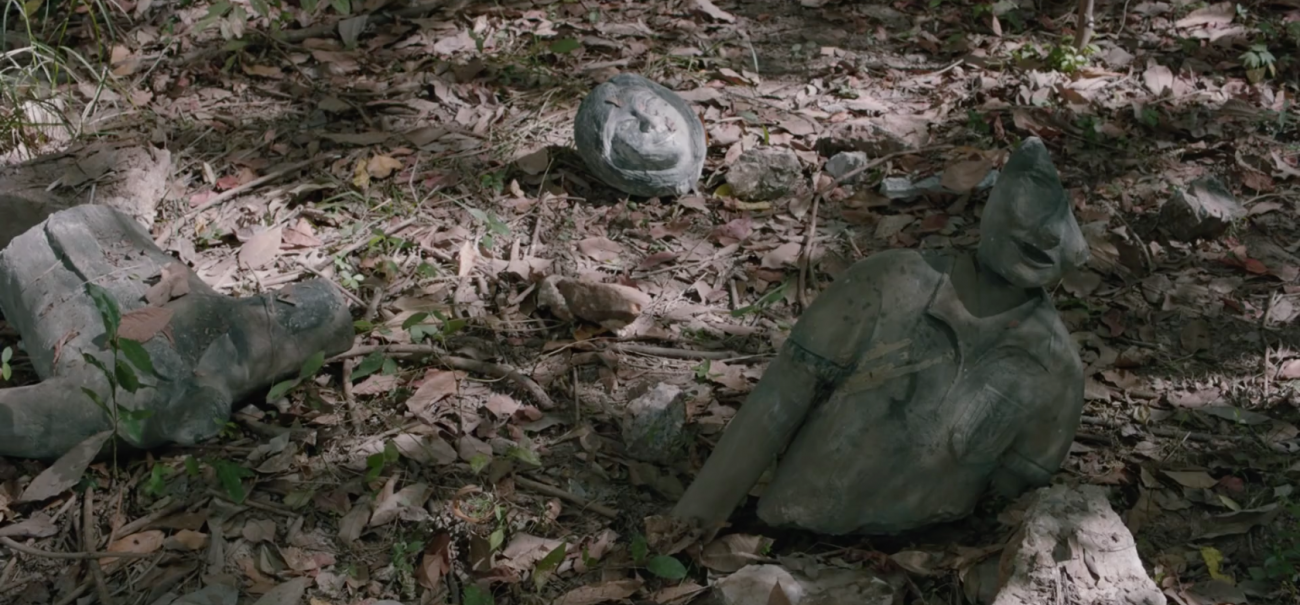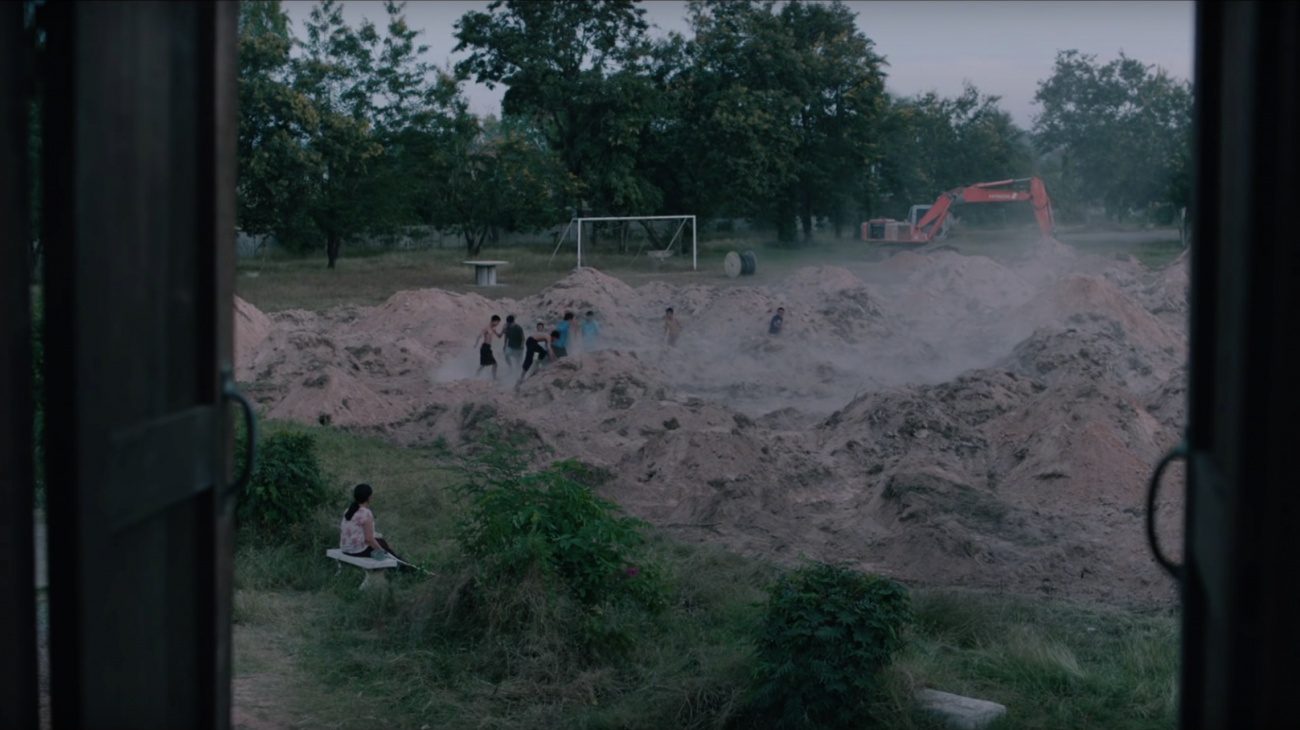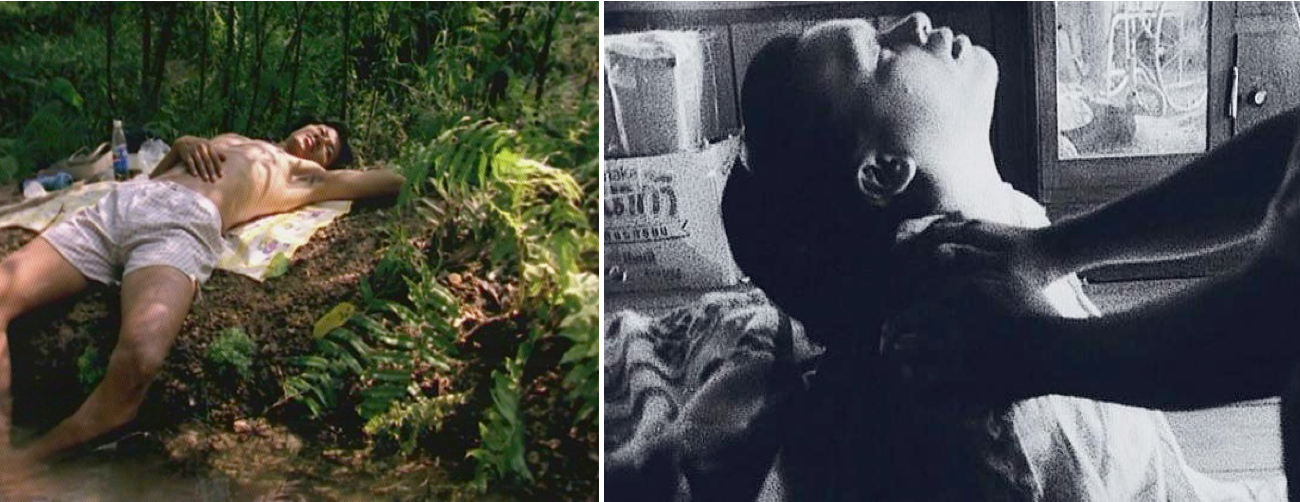Cet article fait partie d’un cycle
Giovanni Marchini Camia was in charge for keeping the production diary on the set of Apichatpong Weerasethakul’s last feature Cemetery of Splendour. More than a glimpse of the atmosphere on the set, this text accounts for the international production process of the film and the Thaï director’s perception of the editing phase.
The 3rd of December 2014 was the final day of the shoot of Apichatpong Weerasethakul’s Cemetery of Splendour, which had lasted a total of 31 days over the preceding two months. That night the majority of the crew went for farewell drinks at a bar near our hotel in downtown Khon Kaen, Apichatpong’s hometown in the Northeast of Thailand where the entire shoot took place. Talking with Sompot Chidgasornpongse (aka Boat[1]), the first assistant director, I shared my anticipation at seeing the finished film. Boat has worked on almost all Joe’s films since Tropical Malady and he guaranteed me that I would be hugely surprised by the final cut. Joe, he said, always radically reworks the film’s structure in the edit and major segments regularly end up on the cutting room floor. Seeing Tropical Malady for the first time had been a shock, not least because two sex scenes had disappeared, one of which filmed with a real tiger. He was convinced that Joe was also going to end up cutting the monster from Cemetery of Splendour: “it’s too extreme.”
The monster had taken up most of the last three days of shooting and had caused the production to run two days over schedule. In the script, just before the protagonists wake up at the end of the film, there was a dream sequence in which the carcass of a large monster is found floating in a lake. Some passers-by pull it to the shore and one of them stabs its side with a knife, causing an eruption of blood filled with yellow flowers. The prop for the monster had been built out of plastic and latex from Joe’s design. It was amazing: roughly the size of a small car, it had the colour of a bruise and looked like a cancerous amalgam of sexual organs and orifices, like something out of an early Cronenberg film. Since the special effect was practical – a man hid inside the monster holding a tube full of fake blood and flowers that were shot out with a powerful pump – it took the art department and effects team three days of tinkering and practice to make it look realistic. It was one of the most difficult and frustrating parts of the shoot and the resulting production delay was both a logistical nuisance and a significant cost. It seemed inconceivable that it wouldn’t appear in the film.
As Boat, the first assistant director, had predicted, the final edit was a big surprise.
Sure enough, when I finally saw Cemetery of Splendour at its triumphant world premiere in Cannes on the 18th of May 2015, the entire scene was gone. Now the monster’s only appearance occurs towards the beginning of the film in an unscripted dream digression, where it can be glimpsed floating in the water, mostly submerged and hardly recognizable. As Boat had predicted, the final edit was a big surprise. The monster wasn’t the only part that was excised, but also entire characters and locations, as well as the scene that had most perplexed the crew during the shoot: again in a dream sequence, Joe’s regular actor Sakda Kaewbuadee (Tong) is seen grooming a soldier’s nipple, first brushing it with a toothbrush and then cutting the hairs around it with nail scissors. This action was captured in a macro shot, with the nipple taking up the whole frame, like a grotesque eye. It was a surreal sight and a violent rupture of the film’s otherwise distanced aesthetic. Like the monster and a number of other elements, however, it was eventually deemed too extreme and cut out. Overall, the completed version of Cemetery of Splendour is a lot more restrained and placid than the script originally envisioned.
Another conspicuous absence was that of a lengthy night-time driving scene, which was supposed to take place roughly at the film’s midpoint, effecting a sort of bifurcation. I fully expected it to be there, not only because driving scenes have appeared in each of Joe’s features ever since the opening shot of his debut, Mysterious Object at Noon, but also because here it served an important structural function, bridging the divide between reality and dream. In its place, there’s now a gorgeous montage that splices together shots of the hospital and other locations around Khon Kaen, some unfamiliar to the viewer. The colours emitted by the phosphorescent tubes that stand by the hospital beds seep into the fabric of the film and spread across cuts in an entrancing phantasmagoria. Only a much more basic version of this scene existed in the script and although it’s now a vital component of the film as well as one of its most powerful sequences, the current version was developed during the edit.
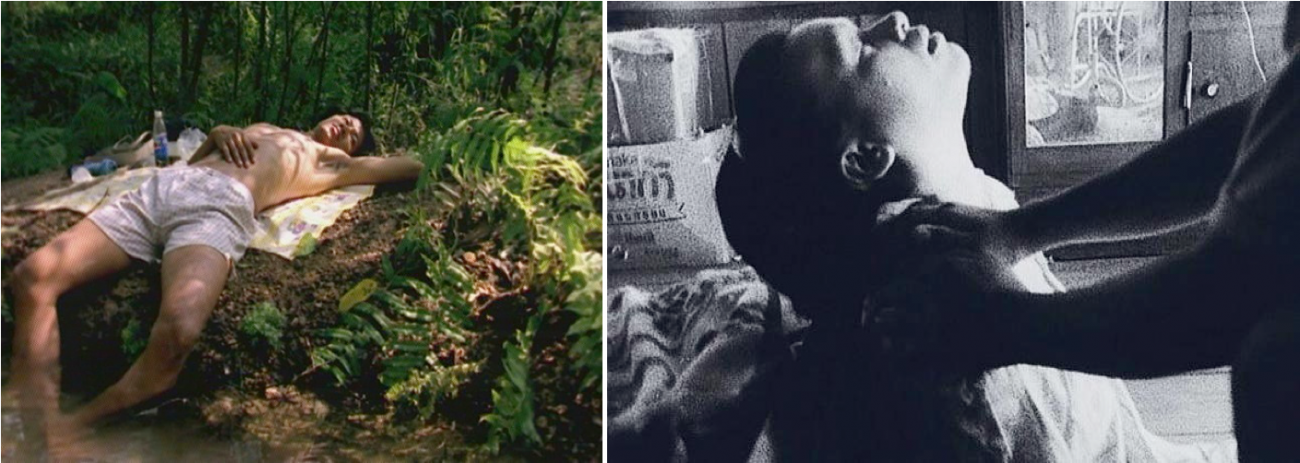
Blissfully Yours (2002) / Mysterious Object at Noon (2000).
This is just one example that highlights the hugely important role played by Joe’s editor Lee Chatametikool (Lee). Lee has edited all of Joe’s major features starting with Blissfully Yours and although he doesn’t attend the shoot, presumably to keep an objective distance from the material, he is deeply involved in every creative aspect of post-production. When I spoke to Joe about the edit, he said he would be lost without Lee. It actually took a fair bit of strategizing to make sure the entirety of the editing and colour correction process took place in Bangkok. As with Joe’s previous features, a significant part of Cemetery of Splendour’s budget came from entities like the Berlinale’s World Cinema Fund and the Norwegian Sørfond, funds that support cinema from countries lacking a strong film infrastructure, each with their own conditions. One of the conditions set by the CNC’s L’aide aux cinémas du monde, a major contributor, was that 50% of its post-production financing had to be spent in France. To this end, part of the edit was originally planned to take place in Paris. However, since the time window for editing was extremely restricted – the shoot ended in December and a cut needed to be submitted to Cannes in March – to make sure Lee could be fully involved, it was eventually resolved that other aspects such as completing the sound mix and preparing the DCPs could be taken care of in France to fulfil the obligations to the CNC.
Cemetery of Splendour’s budget was the biggest of any feature Joe has made to date, nearing €1 million (by comparison, the Palme d’Or-winning Uncle Boonmee Who Can Recall His Past Lives cost around €650,000). To assemble the budget, the two primary production companies – Joe’s own Kick the Machine and Illuminations Film from the UK – secured funding from over a dozen international sources. A few of these have been involved in the production of Joe’s films for years: for example, the French company Anna Sanders Films has collaborated with Joe virtually since the beginning of his feature film career, while the German company Match Factory has been on board since Uncle Boonmee. Smaller contributors, such as Tordenfilm from Norway, received distribution rights in their territories as part of their co-production deal, whereas others, such as Louverture Films from the USA and Detalle Films from Mexico, are purely benefactors.
With so many different companies financially involved, the production was under a lot of scrutiny. This is one of the reasons why I was hired to write a daily journal of the shoot. At the end of each day, once we’d returned to our hotel, I would compile a diary of what had occurred on set and upload it to a private Tumblr account, which was only accessible to the various producers. Joe came up with this idea to take pressure off himself, intending to minimize external distractions while working on the film. As with Lee in post-production, during production Joe also likes to be surrounded by people he knows intimately and he has put together a very close-knit team over the years. There were a lot of new team members on the shoot of Uncle Boonmee, which turned out to be a protracted and very stressful production. By all accounts, the production of Cemetery of Splendour was by far the smoothest of Joe’s career.
From the very first day, I was struck by the atmosphere on set.
From the very first day, I was struck by the atmosphere on set. Customarily, film shoots are hectic environments where intense schedules, long working hours and intemperate egos blend together in a volatile concoction with frequent violent eruptions. The opposite was true here. Over the entire 31 days of shooting, I didn’t witness a single argument between crewmembers, or even so much as a voice being raised. This can in part be explained through the specificity of Thai culture, as emotional outbursts are frowned upon and authority figures can generally expect a greater degree of respect than in the West[2]. However, these cultural attributes can’t account for the impressive and unfailing efficiency of the crew, nor for the jovial ambience that reigned throughout, which never showed any signs of underlying resentment. In this regard, no factor is as important as the familiarity cultivated amongst the team over the last decade and a half.
Amongst the chief crewmembers, the only new addition was the DP, Diego García (Joe’s regular DP, Sayombhu Mukdeeprom, wasn’t available as he had taken a year-long commitment to shoot Miguel Gomes’ Arabian Nights). All the heads of department had first joined the team as interns, many without prior film experience, and worked their way up to their current positions over time. For the most part, they not only work on Joe’s features, but also on his numerous shorts and installations, so that they end up collaborating several times a year. As Joe said, “it’s not only about work. We sometimes just meet for dinner and we talk about movies and stuff, so we know each other’s preferences. It’s really about personality. Political preferences and all these things, they matter to me. If you don’t know another person, it affects the way of talking. We’re not working like in the studio system, in an industrialised, conveyor-belt-kind of organization – it works more like a family.”
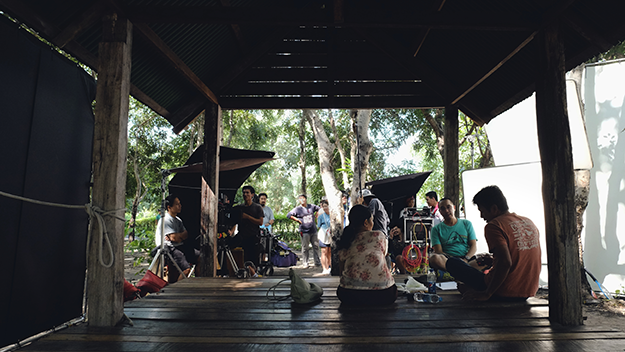
On the set of Cemetery of splendour.
In the early days, when the team was still small, Joe himself looked for new personnel, usually via classified ads, and made sure all new additions to his team were a good fit personality-wise. Now the task has to a large extent been relegated to Boat and to Akekarat Homlaor (Ake), the production designer and head of the art department, who was first hired as a driver and caterer on Blissfully Yours. His department has developed into the main entryway into Joe’s team – the art director, sound recordist and costume designer, for example, all attained their current positions via the art department – and functions as a mini-family in itself. During the shoot, all members of the art department lived together in a separate house that doubled as their workshop and Ake, who is a good decade or so older than the rest, had an effective paternal role. They were also the group with the most active social life and on free days Ake would take them all out to restaurants, bars and clubs on his pick-up truck – hanging out with the art department was always a guarantee for a fun night out. In addition to fostering team spirit and creating tight personal bonds, it was also a productive vetting process, quickly revealing if someone wasn’t on the same wavelength as the rest.
On set, this all translated into an exceptionally streamlined atmosphere. Each department enjoyed a very high degree of independence and the communication with Joe while shooting was largely tacit. Apart from the monster, which had been constructed by an external special effects team that only arrived in the last days, there were no significant delays due to technical issues. The sole variable that hung in the balance were the performances and even though the entire cast was composed of non-professionals, only one actor in a secondary role (who has virtually disappeared from the finished film) proved problematic. This lack of pressure enabled the room for manœuvre necessary for Joe’s highly flexible and improvisatory work method. Responding both to external circumstances and creative impulses, he would regularly rewrite scenes and characters at the last minute or make script alterations between shooting days that called for technical and location changes.
In a few occasions, new actors even had to be cast overnight. The man playing the meditation teacher at the hospital in the film’s first half, for instance, was cast the same morning the scene was shot. The original actor had failed to show up at the previous day’s rehearsal, so three new actors were found and Joe held auditions while the team was setting up the scene. The actor he picked, an engineer and noodle shop owner, couldn’t speak the Isan dialect in which the meditation lecture had originally been written, so his part was rewritten in Central Thai[3]. Although imposed by circumstance, Joe was delighted with the change. As authority figures such as teachers customarily speak in Central Thai, switching languages actually lent the scene greater veracity.
It’s fortunate that the shoot of Cemetery of Splendour was such a smooth and pleasurable experience for the entire team, as the film constitutes a farewell in many ways. Another reason why Joe wanted the production documented, which involved my journal as well as a behind-the-scenes documentary directed by indie filmmaker Nontawat Numbenchapol (Ble), is because he expects this to be his last feature shot in Thailand. It’s not my place to discuss the underlying factors, but suffice it to say that the deep melancholy that pervades Cemetery of Splendour is in large part an expression of his sorrow at the prospect of departing from his homeland and leaving behind the filmmaking family he’s been building since the beginning of his career.
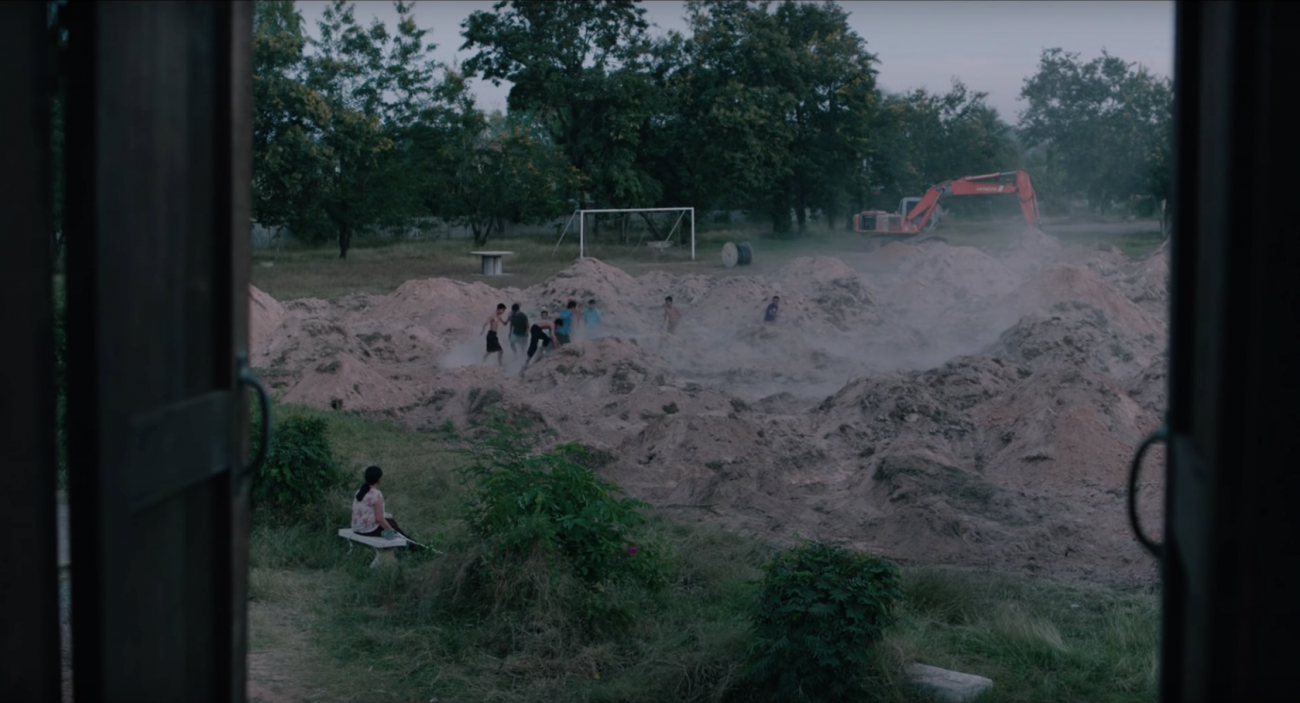
[1] Although Thais generally have very long names, they are also given shorter nicknames by their parents. Longer names are only used in formal contexts, whereas in the everyday, Thais introduce themselves and refer to one another by their nicknames. (Contrary to what is regularly said in foreign articles about Apichatpong, “Joe” (pronounced “Joey”) is not a moniker he assumed for the benefit of non-Thai speakers.)
[2] Lest there be doubts of generalizations, these aren’t conclusions I came to through observation, but explanations given to me by different crewmembers when I expressed surprise at the lack of friction on set.
[3] The role of language is a central dimension of Cemetery of Splendour that will unfortunately be lost on most foreign viewers, being impossible to efficiently convey through subtitles. Isan, the region of Northeastern Thailand where Khon Kaen is located, was traditionally one of the country’s poorest regions. The Isan dialect has come to denote the lower class in Thai media and is exclusively spoken by comical, bumpkin-like characters in films and TV. Starting with Unclee Boonmee and its sister installation Primitive, Joe introduced Isan-speaking characters in his films, highlighting this cultural disparity and effecting a cinematic reclamation by featuring Isan protagonists in serious, dramatic roles. This is also a frequent source of humour in Joe’s films, as in the scene in Cemetery of Splendour where the incarnations of the Two Princesses visit the protagonist Jenjira. Unaware of their true identity, Jenjira speaks to them in the Isan dialect. No one would dare to address royalty in such colloquial terms and her mortification when she discovers who they are is largely due to this misstep.
